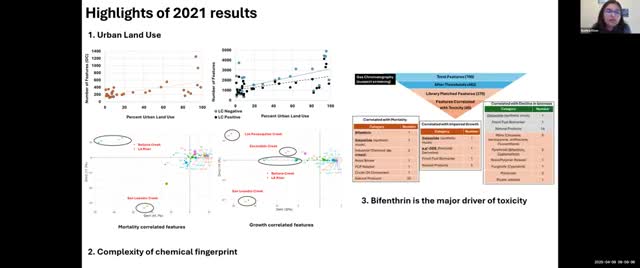NTA study identifies bifenthrin as key toxicity driver in urban waterways
April 26, 2025 | California Water Quality Monitoring Council, Boards and Commissions, Executive, California
This article was created by AI summarizing key points discussed. AI makes mistakes, so for full details and context, please refer to the video of the full meeting. Please report any errors so we can fix them. Report an error »

The California Water Quality Monitoring Council's recent meeting on April 26, 2025, highlighted significant findings regarding the impact of bifenthrin, a common pesticide, on water toxicity levels across the state. The discussions underscored the importance of ongoing monitoring and analysis to ensure the safety of California's water resources.
Key findings revealed that bifenthrin continues to be a major contributor to toxicity in water samples, validated by data collected from 90 sites over several years. The prioritization model developed by researchers has proven effective in identifying this pesticide as a consistent driver of toxicity, reinforcing the need for targeted monitoring efforts.
The meeting also addressed the challenges faced in data collection, particularly in 2021, where targeted chemistry work yielded minimal results. However, advancements in non-targeted analysis (NTA) have allowed researchers to quantify additional contaminants, including fipronil, which is also significant in toxicity assessments. This dual approach of targeted and non-targeted analysis is crucial for building comprehensive trends and understanding the broader implications of chemical presence in water bodies.
Participants discussed the implications of these findings for local communities, emphasizing the need for continued vigilance in monitoring water quality. The data collected not only informs regulatory actions but also helps in understanding the effects of land use on water toxicity. The integration of qualitative and quantitative data from NTA can enhance the effectiveness of water quality management strategies, ensuring that emerging contaminants are identified and addressed promptly.
In conclusion, the meeting reinforced the critical role of ongoing research and monitoring in safeguarding California's water quality. As the state grapples with environmental challenges, the findings serve as a reminder of the importance of informed decision-making to protect public health and the environment. The Council plans to continue its efforts in refining monitoring techniques and addressing the evolving landscape of water contaminants.
Key findings revealed that bifenthrin continues to be a major contributor to toxicity in water samples, validated by data collected from 90 sites over several years. The prioritization model developed by researchers has proven effective in identifying this pesticide as a consistent driver of toxicity, reinforcing the need for targeted monitoring efforts.
The meeting also addressed the challenges faced in data collection, particularly in 2021, where targeted chemistry work yielded minimal results. However, advancements in non-targeted analysis (NTA) have allowed researchers to quantify additional contaminants, including fipronil, which is also significant in toxicity assessments. This dual approach of targeted and non-targeted analysis is crucial for building comprehensive trends and understanding the broader implications of chemical presence in water bodies.
Participants discussed the implications of these findings for local communities, emphasizing the need for continued vigilance in monitoring water quality. The data collected not only informs regulatory actions but also helps in understanding the effects of land use on water toxicity. The integration of qualitative and quantitative data from NTA can enhance the effectiveness of water quality management strategies, ensuring that emerging contaminants are identified and addressed promptly.
In conclusion, the meeting reinforced the critical role of ongoing research and monitoring in safeguarding California's water quality. As the state grapples with environmental challenges, the findings serve as a reminder of the importance of informed decision-making to protect public health and the environment. The Council plans to continue its efforts in refining monitoring techniques and addressing the evolving landscape of water contaminants.
View full meeting
This article is based on a recent meeting—watch the full video and explore the complete transcript for deeper insights into the discussion.
View full meeting
